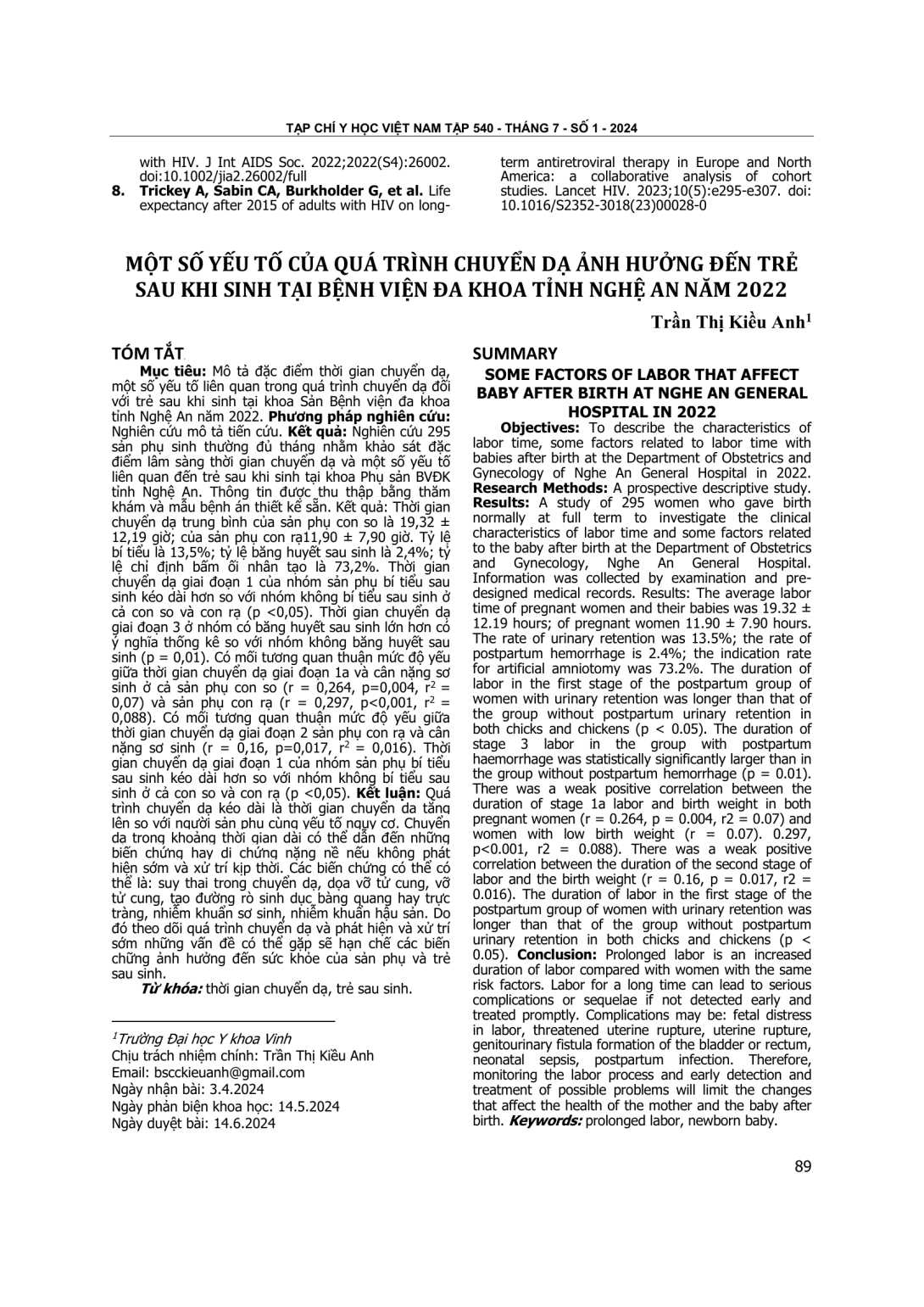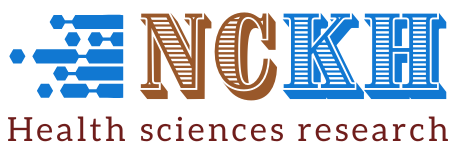
Mô tả đặc điểm thời gian chuyển dạ, một số yếu tố liên quan trong quá trình chuyển dạ đối với trẻ sau khi sinh tại khoa Sản Bệnh viện đa khoa tỉnh Nghệ An năm 2022. Phương pháp nghiên cứu: Nghiên cứu mô tả tiến cứu. Kết quả: Nghiên cứu 295 sản phụ sinh thường đủ tháng nhằm khảo sát đặc điểm lâm sàng thời gian chuyển dạ và một số yếu tố liên quan đến trẻ sau khi sinh tại khoa Phụ sản BVĐK tỉnh Nghệ An. Thông tin được thu thập bằng thăm khám và mẫu bệnh án thiết kế sẵn. Kết quả: Thời gian chuyển dạ trung bình của sản phụ con so là 19,32 ± 12,19 giờ; của sản phụ con rạ11,90 ± 7,90 giờ. Tỷ lệ bí tiểu là 13,5%; tỷ lệ băng huyết sau sinh là 2,4%; tỷ lệ chỉ định bấm ối nhân tạo là 73,2%. Thời gian chuyển dạ giai đoạn 1 của nhóm sản phụ bí tiểu sau sinh kéo dài hơn so với nhóm không bí tiểu sau sinh ở cả con so và con rạ (p <0,05). Thời gian chuyển dạ giai đoạn 3 ở nhóm có băng huyết sau sinh lớn hơn có ý nghĩa thống kê so với nhóm không băng huyết sau sinh (p = 0,01). Có mối tương quan thuận mức độ yếu giữa thời gian chuyển dạ giai đoạn 1a và cân nặng sơ sinh ở cả sản phụ con so (r = 0,264, p=0,004, r2 = 0,07) và sản phụ con rạ (r = 0,297, p<0,001, r2 = 0,088). Có mối tương quan thuận mức độ yếu giữa thời gian chuyển dạ giai đoạn 2 sản phụ con rạ và cân nặng sơ sinh (r = 0,16, p=0,017, r2 = 0,016). Thời gian chuyển dạ giai đoạn 1 của nhóm sản phụ bí tiểu sau sinh kéo dài hơn so với nhóm không bí tiểu sau sinh ở cả con so và con rạ (p <0,05). Kết luận: Quá trình chuyển dạ kéo dài là thời gian chuyển dạ tăng lên so với người sản phụ cùng yếu tố nguy cơ. Chuyển dạ trong khoảng thời gian dài có thể dẫn đến những biến chứng hay di chứng nặng nề nếu không phát hiện sớm và xử trí kịp thời. Các biến chứng có thể có thể là: suy thai trong chuyển dạ, dọa vỡ tử cung, vỡ tử cung, tạo đường rò sinh dục bàng quang hay trực tràng, nhiễm khuẩn sơ sinh, nhiễm khuẩn hậu sản. Do đó theo dõi quá trình chuyển dạ và phát hiện và xử trí sớm những vấn đề có thể gặp sẽ hạn chế các biến chững ảnh hưởng đến sức khỏe của sản phụ và trẻ sau sinh.
To describe the characteristics of labor time, some factors related to labor time with babies after birth at the Department of Obstetrics and Gynecology of Nghe An General Hospital in 2022. Research Methods: A prospective descriptive study. Results: A study of 295 women who gave birth normally at full term to investigate the clinical characteristics of labor time and some factors related to the baby after birth at the Department of Obstetrics and Gynecology, Nghe An General Hospital. Information was collected by examination and pre-designed medical records. Results: The average labor time of pregnant women and their babies was 19.32 ± 12.19 hours; of pregnant women 11.90 ± 7.90 hours. The rate of urinary retention was 13.5%; the rate of postpartum hemorrhage is 2.4%; the indication rate for artificial amniotomy was 73.2%. The duration of labor in the first stage of the postpartum group of women with urinary retention was longer than that of the group without postpartum urinary retention in both chicks and chickens (p < 0.05). The duration of stage 3 labor in the group with postpartum haemorrhage was statistically significantly larger than in the group without postpartum hemorrhage (p = 0.01). There was a weak positive correlation between the duration of stage 1a labor and birth weight in both pregnant women (r = 0.264, p = 0.004, r2 = 0.07) and women with low birth weight (r = 0.07). 0.297, p<0.001, r2 = 0.088). There was a weak positive correlation between the duration of the second stage of labor and the birth weight (r = 0.16, p = 0.017, r2 = 0.016). The duration of labor in the first stage of the postpartum group of women with urinary retention was longer than that of the group without postpartum urinary retention in both chicks and chickens (p < 0.05). Conclusion: Prolonged labor is an increased duration of labor compared with women with the same risk factors. Labor for a long time can lead to serious complications or sequelae if not detected early and treated promptly. Complications may be: fetal distress in labor, threatened uterine rupture, uterine rupture, genitourinary fistula formation of the bladder or rectum, neonatal sepsis, postpartum infection. Therefore, monitoring the labor process and early detection and treatment of possible problems will limit the changes that affect the health of the mother and the baby after birth.
- Đăng nhập để gửi ý kiến
